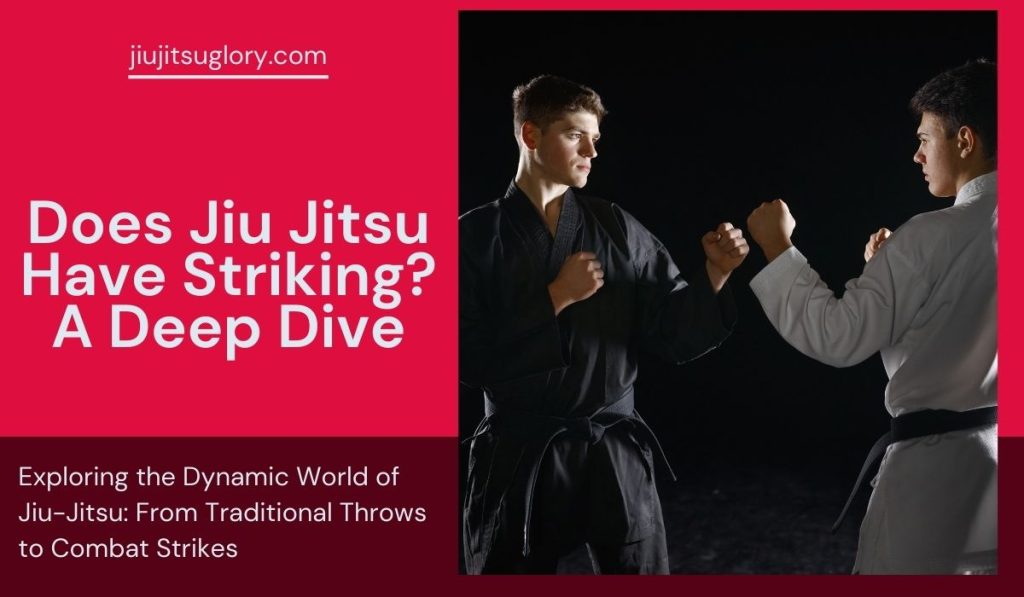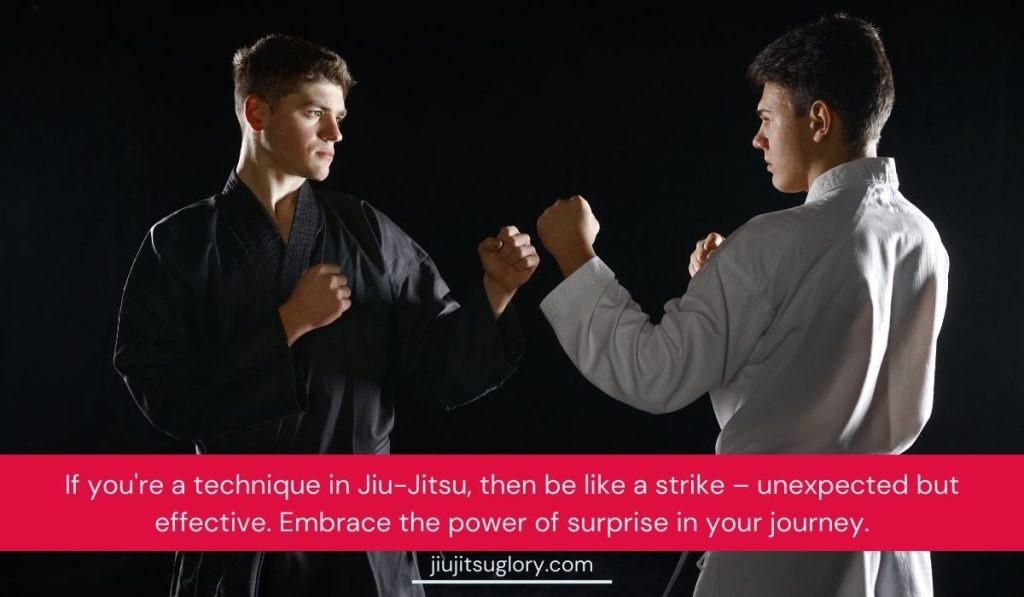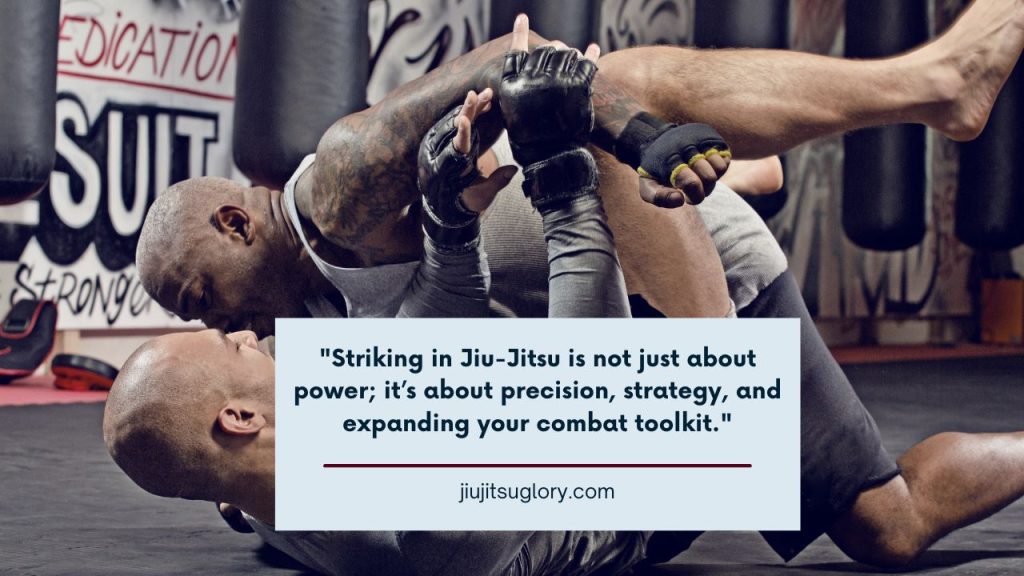Brazilian Jiu-Jitsu is renowned for its focus on grappling and submissions, making it a dominant force in ground fighting. However, as martial arts evolve, there’s an increasing recognition of the value of integrating striking into Jiu-Jitsu.
Understanding striking within a Jiu-Jitsu framework enhances a practitioner’s versatility and combat effectiveness, addressing situations where pure grappling might not be sufficient.
This article delves into the incorporation of striking into Jiu-Jitsu, discussing its benefits and training methods and providing a comprehensive outlook on this hybrid martial art form.

Overview of Jiu-Jitsu
Jiu-Jitsu, also known as Jujutsu or Jujitsu, is a martial art and combat sport focusing on grappling and ground fighting techniques. It originated in Japan and has been practiced for centuries.
“Jiu-Jitsu” literally translates to “gentle art,” emphasizing efficient and effective techniques that individuals of all sizes and strengths can use.
Jiu-Jitsu is a martial art that utilizes leverage and technique to overcome opponents, regardless of size or strength. It is often characterized by its ground fighting techniques, joint locks, and chokehold.
The primary goal of Jiu-Jitsu is to gain control over an opponent and submit them through the application of various holds and submissions.
The Different Styles of Jiu-Jitsu

Brazilian Jiu Jitsu
Brazilian Jiu-Jitsu (BJJ) is a style of Jiu-Jitsu developed by the Gracie family in the early 20th century. It is known for its emphasis on ground fighting techniques and the application of submissions.
BJJ differs from other styles of Jiu Jitsu in that it focuses heavily on positional control, allowing practitioners to neutralize and submit their opponents from various positions.
Japanese Jiu Jitsu
Japanese Jiu-Jitsu, or traditional Jiu-Jitsu, refers to the original form of Jiu-Jitsu practiced in Japan.
It incorporates many striking, throwing, joint-locking, and grappling techniques. Japanese Jiu-Jitsu places importance on striking techniques and self-defense scenarios.
Combat Jiu-Jitsu
Combat Jiu-Jitsu is a martial art that evolved from Brazilian Jiu-Jitsu, emphasizing striking and ground fighting.
The addition of strikes in Combat Jiu-Jitsu aims to bridge the gap between Brazilian Jiu-Jitsu and mixed martial arts (MMA), where striking plays a crucial role in combat.
Striking is not allowed in Brazilian Jiu-Jitsu competitions. However, in Combat Jiu-Jitsu, competitors can use open-handed strikes when both fighters are on the ground.
This modification encourages fighters to incorporate strikes into their grappling, making the matches more dynamic and realistic.
In Combat Jiu-Jitsu, open-handed slaps are the typical form of strike instead of closed-fist punches. This approach minimizes the risk of severe injury. It makes the sport more accessible to practitioners who may not have extensive striking experience.
However, joint locks, chokes, and position control remain the primary focus of martial arts. Still, the inclusion of strikes adds an extra layer of complexity.
Is There Striking in Jiu-Jitsu?

Striking is not a part of Brazilian Jiu-Jitsu. BJJ focuses instead on grappling techniques, such as throws, takedowns, joint locks, and chokeholds, to control and submit the opponent on the ground.
Striking is prohibited in Brazilian jiu-jitsu training or competitions, where practitioners spar in ” rolling ” matches.
Meanwhile, Japanese Jiu-Jitsu includes striking techniques, throws, joint locks, weapon techniques, kicks, and punches. The martial art was developed for samurai as a battlefield combat system.
In traditional Japanese Jiu-Jitsu schools, practitioners learn both grappling and striking, reflecting the martial art’s origins as a method of unarmed combat for warriors.
In addition, Combat Jiu-Jitsu incorporates striking when both competitors are on the ground. The strikes are typically open-hand slaps rather than closed-fist punches.
This newborn jiu-jitsu style was developed to bridge the gap between BJJ and mixed martial arts (MMA), where striking is integral.
Benefits of Striking in Jiu-Jitsu

Integrating striking into Jiu-Jitsu offers numerous benefits, particularly in enhancing self-defense capabilities.
In real-world scenarios, an aggressor might not engage in grappling but instead rely on punches, kicks, or other strikes.
Proficiency in striking allows a Jiu-Jitsu practitioner to respond effectively, creating opportunities to close the distance and apply grappling techniques.
For MMA competitors, striking skills are essential, as the sport encompasses all aspects of fighting, including striking, clinching, and ground combat.
Moreover, learning to strike can improve a practitioner’s overall combat awareness and coordination, making them more well-rounded martial artists.
The psychological benefits are also notable, as practitioners gain confidence knowing they can handle various forms of attack.
Ultimately, integrating striking into Jiu-Jitsu provides a more complete fighting system capable of addressing a more comprehensive range of combat situations.
See Also: How Many Calories Does Jiu-Jitsu Burn?
Conclusion
Brazilian Jiu-Jitsu does not involve striking; it is a grappling art. Japanese Jiu-Jitsu, with its broader scope as a traditional martial art, does include striking techniques.
Otherwise, combat Jiu-Jitsu incorporates limited striking (open-hand strikes) but only in specific ground fighting scenarios.
Each style offers a different perspective on the role of striking in Jiu-Jitsu, reflecting their unique historical and practical applications.

Related: The search for the perfect soap for Jiu-Jitsu enthusiasts is about maintaining cleanliness and embracing a lifestyle that prioritizes health, hygiene, and the art of martial arts. Read More!


